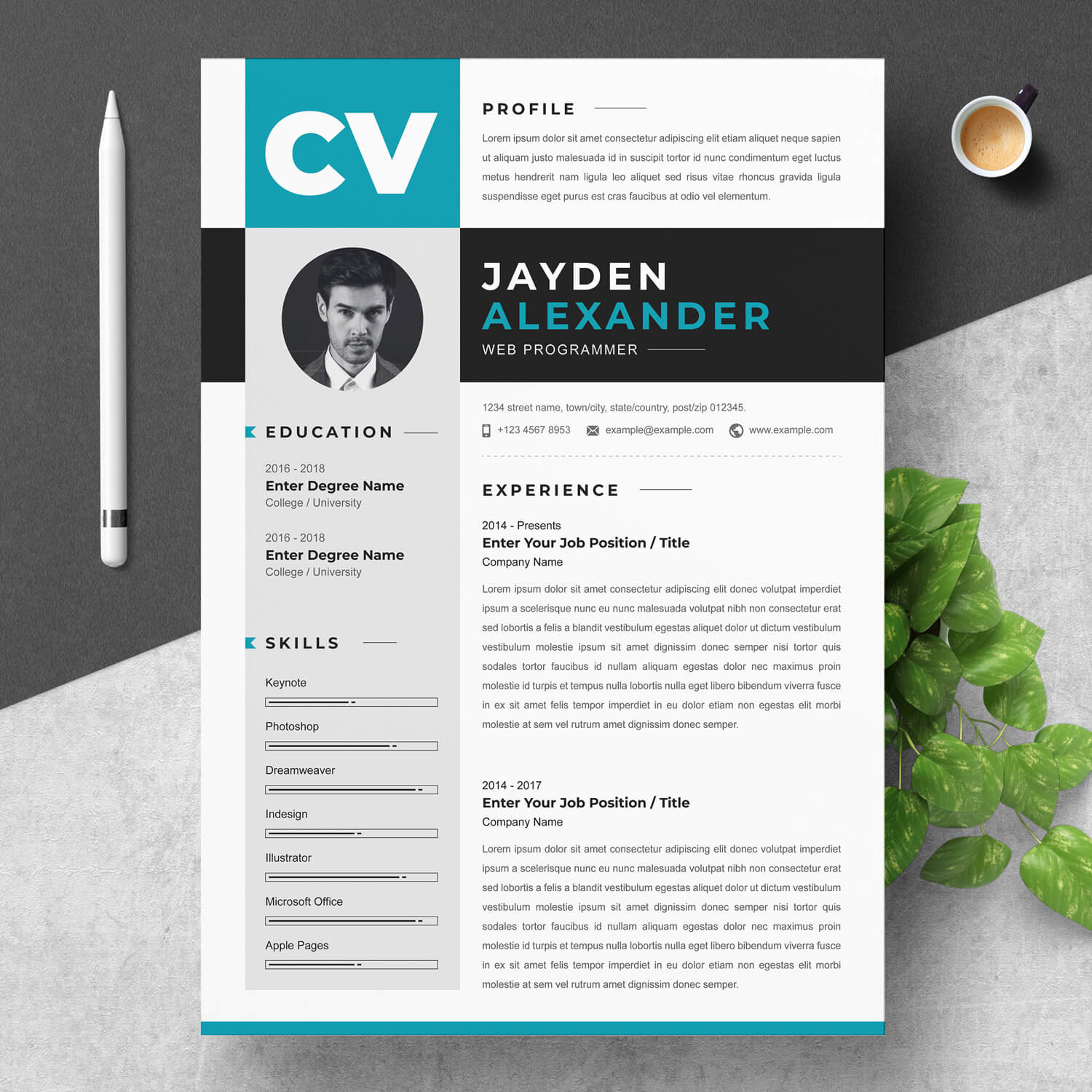CV Templates in LaTeX – Creating a resume template is easier than you think. Once you learn some basic LaTeX coding, you can create a resume template that’s easy to customize.
As you may know, I’m a big fan of LaTeX and its many applications. I love LaTeX so much that I have written a book about it. In addition to writing in LaTeX, I believe that anyone who wants to work with LaTeX should be able to do so.
When you need to create a professional resume, you need a resume template that is visually appealing, easy to customize, and that will showcase your skills and accomplishments.
One of the essential elements of a resume is its appearance. A well-designed resume will help you stand out from the crowd and show off your talents.
In this post, we will go through creating a resume template using LaTeX, and we will give you tips on how to make the best CV template ever.
Nowadays, most people don’t go to work without a professional CV, and a good one is essential. We’ve got you covered!
We will give you the basics and a few tips on creating an excellent CV template.
You can use this template to put together a CV for a job application, your profile, or anything else.
If you need a friendly, neat, and professional CV, this one is for you.

What is a CV template?
Your CV is a document that showcases your skills, qualifications, and experience. It serves as a reference for hiring managers and recruiters and is the most essential tool in your job search.
But before you begin crafting your resume, you should know a few things about CVs.
A CV template is a document that helps you format your resume. It’s usually used in the context of hiring managers and HR professionals. A CV template typically includes a cover letter, a summary of your experience, and a list of skills.
You can use a few different types of templates, but the most common is the chronological one. This is where you list your professional experience in reverse chronological order. You usually start with the most recent experience and work your way back.
A template usually includes some basic information about you. For example, you might include your name, job title, email address, and phone number.
A template also includes a summary of your work experience. This is where you talk about the types of positions you’ve held and the companies that you’ve worked for.
The final section is a list of skills. This is where you talk about the things you’ve learned during your career. These could be technical skills, leadership skills, interpersonal skills, etc.
This is a short essay that you can use to summarize the main points of your blog post. In this case, you’ll use it to summarize your top three highest-paying work-from-home jobs without a degree.
The most important thing to remember when writing your CV is that it needs to be specific to the job you’re applying for. If you don’t know what you’re looking for, you won’t be able to write a compelling summary.
For example, if you’re applying to work as a nurse, you’ll need a very different CV than you would if you were applying for a job as a personal trainer.
In addition to your CV, you may also want to include a cover letter and maybe even a portfolio. These are all optional, but you may want to include them if the job posting requests them.
When you’re ready to start writing, make sure you have a solid outline. Otherwise, it’s easy to get lost in the details and forget why you’re writing in the first place.
You can also check out our other blog posts for more information about writing a CV.
Create a CV template in LaTeX
In LaTeX, we have a lot of powerful features and tools to help us write beautiful documents quickly. One such feature is called the “template.” The template is a collection of commands that we use to format our document into a desired state.
The template is very useful because it allows us to focus on just writing the document rather than formatting every paragraph. When creating a new record, the template is loaded automatically.
CV Templates are essential for creating a professional resume and cover letter. Most employers these days expect you to include a CV with your application.
It’s also essential to include a CV template if you are applying for an academic position or working in an industry that requires a standardized format.
Since many people find creating a CV template difficult, I will show you how to do it using LaTeX.
LaTeX is a typesetting language based on the TeX typesetting system. It was developed by Donald E. Knuth for his book “The Art of Computer Programming” (volumes 3 & 4) and was subsequently released as a free software package.
Firstly, make sure you use a professional-looking font. It doesn’t have to be fancy, but make sure it is readable.
Secondly, make sure the font is consistent throughout your CV. Don’t mix fonts.
Thirdly, include information on every section of your CV. It’s good to have your contact details included and a professional email address (not a personal Gmail).
Finally, don’t just list your skills. Include a paragraph detailing what you’ve done in the past. What do you do?

Why use a CV template in LaTeX
Writing a CV in LaTeX is a powerful tool that can highlight your skills and experience. It also makes it easy to convert your CV into other formats like Microsoft Word and PDF.
This year, the world will focus on the quality of your resume. Why? Because companies are looking for people who have a unique story to tell. This is why we recommend that you use a CV template in LaTeX.
Not only does it make the resume look professional, but it also helps you showcase your skills. Plus, it will save you a ton of time when you start applying to jobs.
A good CV template should highlight your skills, achievements, and interests. In other words, it should include a cover letter, a resume, and a CV.
It should be easy to customize, and it should include a cover letter, a resume, and a CV.
As you can see, using a CV template in LaTeX is pretty easy. And when you’re finished, you can simply export it to a PDF format. If you’re a LaTeX expert, you can probably handle it yourself.
However, if you’re new to LaTeX, then you might find it easier to use a template. For example, if you’re using Word, you can simply copy and paste the information into a text editor and change it as needed.
Frequently Asked Questions (FAQs)
Q: What do you like best about CV templates?
A: A well-organized CV template is elementary to work with, and it makes creating my CV much easier.
Q: What would you change about CV templates?
A: I think there should be more flexibility in adding more sections or moving things around. For example, I always wanted to add my resume, but I couldn’t find a suitable template that allowed me to do this.
Q: Why do you like LaTeX?
A: LaTeX is a programming language used to typeset computer documents. It’s also a versatile tool, and I think it’s pretty easy to learn. I like the fact that you can make adjustments to any part of your document, and if you’re not happy with something, you can simply retype the entire section again.
Q: What are you using to write your CV?
A: My CV is written in LaTeX, and I use the Tufte-cv package to create it.
Myths About CV Templates
CV Templates are one of the most popular ways to make money online. However, there are many things to consider when deciding if this is a good option.
It’s also important to know what kind of a template you’re looking for. There are templates for everything from graphic design to writing to web development.
A CV template is a great way to showcase your resume to potential employers. It’s also an excellent way to stand out among the competition. There are hundreds of different templates available, but none are perfect.
The first thing you need to think about when writing a CV is whether you are applying for a job or being interviewed.
If you are applying for a job, you are looking for someone to hire, so your CV will be very different from that of an interviewer who is looking to employ you.
Conclusion
In this tutorial, I will show you how to create a CV template in LaTeX.
This is one of the best ways to present yourself in an easy-to-read format. I’ve created one myself and will walk you through how to create a similar version.
If you have any questions, feel free to leave them in the comments below, and I’ll be happy to answer them.
This article aims to show you how to create a template in LaTeX. I wanted to write this article because I think templates are underrated.
They are helpful, especially when you are trying to get into writing. Creating a template allows you to quickly create a professional-looking resume, cover letter, or document without wasting time and effort.













